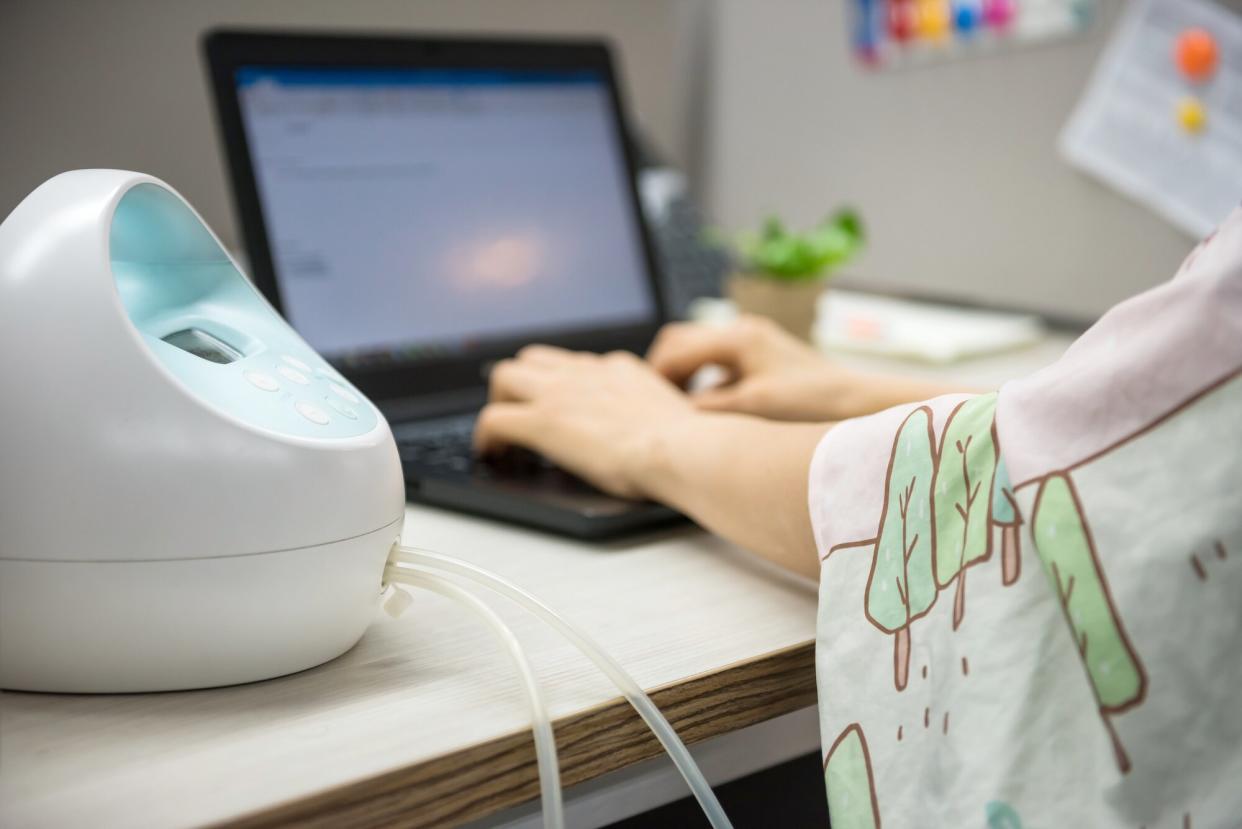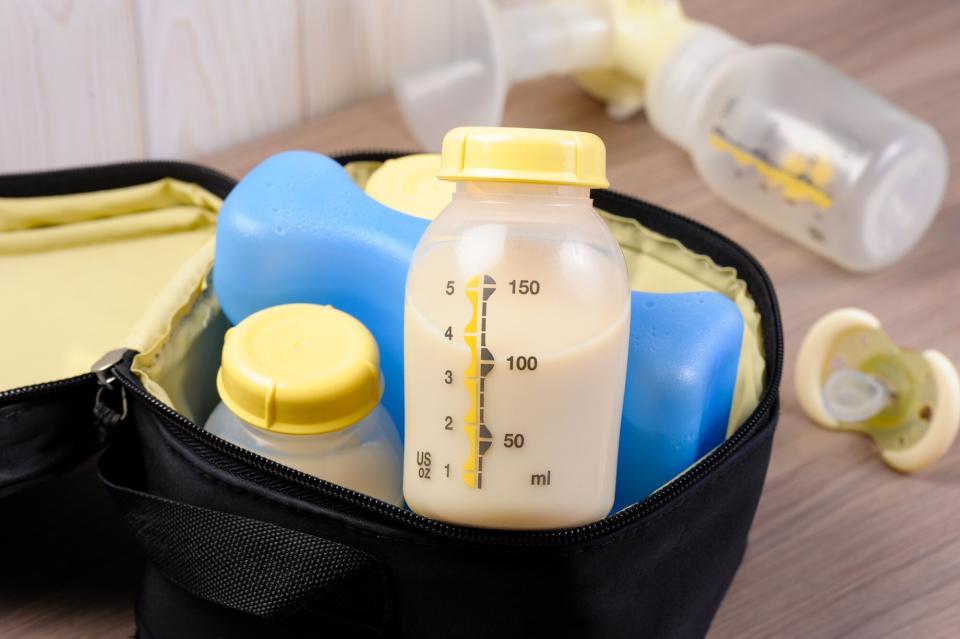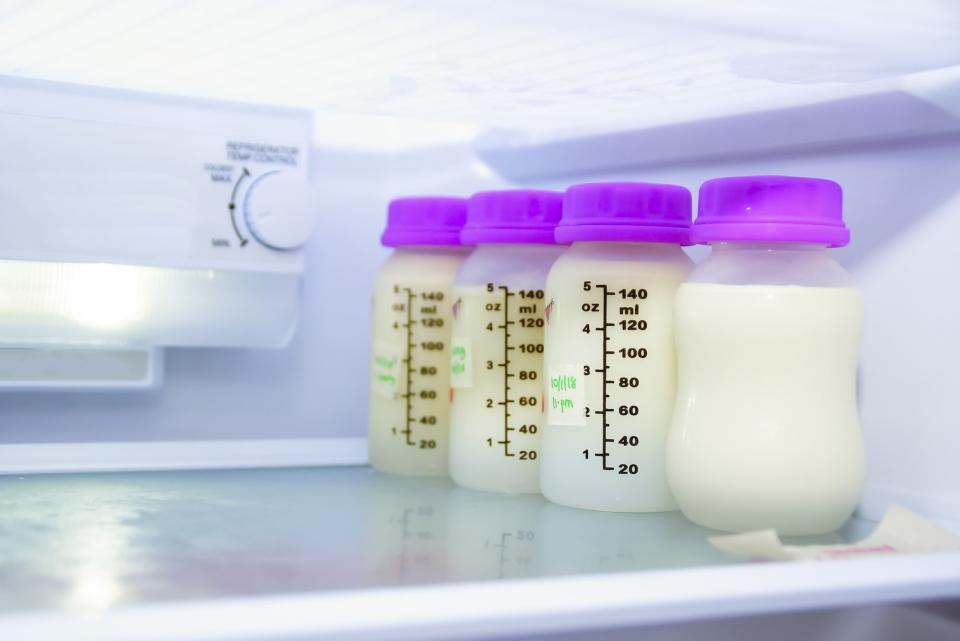12 Easy Fixes for Pumping at Work

Blanscape/Shutterstock
The toughest decision many working moms face is whether to wean or continue breastfeeding. To nurse while working outside the home, you'll need to feed your baby immediately before and after work—and if you decide to nurse exclusively, you'll have to express milk on the job and then transport it home. This requires the use of a breast pump; those that can be used on both breasts at once are the most efficient.
Even though it sounds inconvenient, pumping at work has many advantages. You'll keep giving your baby all the benefits of breastfeeding, including a decreased risk of allergy and illness. Plus, when you breastfeed again after the workday, you'll provide some valuable skin-to-skin contact and emotional closeness that you'll both appreciate.
The key to pumping at work is preparing yourself and your baby for the separation. Once your milk supply is well established—usually after about six weeks—have your husband feed the baby an occasional bottle filled with breast milk or formula. (Offering a bottle earlier than three weeks may lead to nipple confusion and interfere with milk production; if you wait too long, however, the baby may become so attached to your breast that he will refuse the bottle.) It's not a good idea to bottle-feed the baby yourself at first, since he's accustomed to nursing at your breast and may become confused.
Now that you've decided to continue breastfeeding at work, it's time to figure out logistics. When I was a new working mother, I found it tricky to find the ideal spot and time to pump. What I craved were solutions, like these, to the perplexing situations pumping at work can present.
"There's no pumping room available where I work."
The Fix: Talk to the HR department. Under the Affordable Care Act (part of the Fair Labor Standards Act), many employers must give nursing moms a place to express milk, as well as "reasonable" unpaid pumping breaks for one year after the birth of a child. The designated pumping space must be shielded from view and available when you need it—and it can't be a bathroom.
If your office does have a lactation room, scope it out pre-baby. "I assumed that I could just go in and use our 'mothers' room' whenever," says Annie Grant of Newburyport, Massachusetts. "But I had to be added to a special calendar, have my security badge re-coded to gain access, and schedule times with another woman. It worked out, but for a few hours, when I was bursting at the seams, I couldn't do what I needed to do."
If your workspace doesn't have a lactation room, search for alternative solutions. Your own office with a door that closes is great. In a pinch, a woman's bathroom, a spare office, or a conference room where there is privacy, an electrical outlet (if you have an electric pump), and a chair to sit in will work. Consider asking your supervisor for mini blinds for added privacy.
"A pump is too expensive!"
The Fix: Priced at $200 to $400, a high-quality electric pump is an investment—yet it still costs less than the formula you'd buy if you weren't nursing, says Maeve Howett, Ph.D., R.N., a board-certified lactation consultant in Atlanta. Just one month of formula can run well over $200, and prices rise if you purchase the ready-to-feed kind. Double electric pumps also have another advantages that justifies the high cost: they allow you to efficiently pump both breasts at the same time, so you can express enough milk for a full feeding in 10 minutes. Check with your health insurance company if you're planning to purchase a breast pump; your healthcare plan might cover all or part of the cost. Breastfeeding pumps and accessories can also be paid for with funds set aside in flexible spending accounts.
"My day's a whirlwind, and I sometimes forget to pump."
The Fix: Block out pumping sessions in your office calendar (mark it "personal"). Plan to pump when you would breastfeed if you were with Baby, suggests Nancy Hurst, Ph.D., R.N., director of Women's Support Services at Texas Children's Pavilion for Women, in Houston. That might be every three hours if your babe is younger than six months (10 a.m., 1 p.m., and 4 p.m.), twice during a workday for babies six to 10 months (11 a.m. and 3 p.m.), and once midday after that. Plan for each session to take 10 to 20 minutes, including cleanup; you'll likely produce three or four ounces of milk per session.
"Cleaning the parts is weird."
The Fix: Carry a surplus of supplies. "I bring three sets of pump parts to the office—one for each session—and take them home to wash them," says Holly Hosler, a Baltimore mom. Or you can sanitize breast pumps discreetly during the day. Jennifer Seyler, a mom in Chicago, quickly cleaned parts at her desk after her morning session with disinfectant wipes made for pump accessories. After her second pump, she rinsed the parts in the kitchen and sterilized them in a micro-steam bag.
"It's so hard to relax while pumping at work."
The Fix: Your body triggers the release of milk (known as letdown) in response to the sound and feel of your baby's sucking, so it may be difficult to simulate breastfeeding at work. To make matters worse, stress produces adrenaline, which blocks oxytocin, the hormone that jump-starts the letdown. Thankfully, Hurst says women who pump will eventually experience letdown from a machine's whirring sound and feel.
Give your body time to respond to the pump. To encourage milk production, try looking at cute photos or watching videos of your cooing baby on your phone while you pump. If channeling those smiles causes you to miss your baby, or if you begin to worry about how much milk you're making, change the approach. One mom told Hurst that her best trick for a quick letdown was to imagine money falling from the sky. Jen Jamar, a mom in Robbinsdale, Minnesota, found she had an easier time expressing milk if she spent her session catching up on Facebook or Twitter, or flipping through a favorite magazine. "Make pumping your time," Jamar suggests.

Nor Gal/Shutterstock
"I feel awkward stripping down for pumping at work."
The Fix: When choosing outfits for the day, stick with button-downs, wrap dresses, or nursing tanks worn underneath a jacket or cardigan. Even if you have access to a private pumping room, you may find you're happier in easy-access nursing tanks and cardis. For days when a zip-up dress is required, toss a sweater over your shoulders; you'll be grateful for the extra layer when you need to disrobe for pumping.
"I don't know where to store the milk."
The Fix: Breast milk is perishable, so you need to take measures to keep your supply from spoiling. Knowing how to best transport, freeze, and thaw your breast milk is critical. Johanna Moyal, of Los Angeles, stored her milk in bottles in a mini fridge in her office. She brought them home in a cooler, then transferred the milk to freezer bags marked with the date and the ounces in each. A stash can be a lifesaver when your milk production is low or if you have to dump expressed milk because of medications.
Breast milk can stay fresh in a refrigerator for up to seven days. In a freezer, it's good for four months. Once you thaw the milk, use it within 24 hours and do not refreeze it. Two ounces is a good volume for freezing. Leave some space at the top of the bag for the milk to expand while freezing.
"I can't get anything done."
The Fix: You shouldn't expect to hold court in a conference room while filling milk containers, but there's a lot you can do while pumping at work. For example, consider catching up on email, reviewing a document, or sitting in on conference calls with the speaker on mute (no one will have a clue).
"My milk supply is down."
The Fix: Nurse often in the evenings and on weekends, since the more milk you're moving, the more you'll make. You can also add a pumping session immediately after your baby's first morning feed. Your body tends to make the most milk in the morning, Howett says. Plus, most babies sleep their longest stretch at night, so you're likely to wake up with enough breast milk to nurse your baby and express a few ounces. Another way to increase milk supply: guzzle fluids. "A lot of women who tell me they're not making enough milk aren't drinking enough water," says Teresa Hoffman, M.D., a Baltimore-based ob-gyn. You need 15 glasses of water per day—and more if you exercise. You know you're hydrated when your pee is pale yellow.
Sometimes, though, pumping isn't enough, so moms may mix formula with expressed breast milk.

Noor Haswan Noor Azman/Shutterstock
"Pumping eats up lunchtime."
The Fix: Trying to figure out the logistics for how to pump at work? Even if pumping doesn't count against your lunch break from your employer's perspective (ask your HR department), you're a working mom and efficiency reigns supreme. Pack a sandwich for lunch, and toss some protein-rich snacks, such as string cheese and low-fat yogurt, into your bag. This way, you won't have to run out for food or succumb to "I'm starving" stress.
There's also a reassuring upside to the schedule change: You may make some new friends! At one point, Jean Flores, a labor and delivery nurse in Miami, was one of six women in her department hitting the pumping room. During lunch, they'd fill bottles, eat, and catch up on their charts. "We had great camaraderie and an amazing built-in support network," Flores says. Talk about nourishment!
"I have to travel for work."
The Fix: If you're jetting off to a faraway business trip, don't leave without your pump's battery pack, since you may need to set up shop in an airport bathroom stall with no outlet. Lindsey Burik, a New York City mom who flew for work while pumping, advises bringing along a dish towel (to set supplies on), pump-cleaning wipes, and a sealable plastic bag for ice. "You can't bring melted ice through security, so when flying home, I'd dump the ice that was chilling my milk before I got to security, then get new ice in the terminal," she says. She requested a mini fridge for storing milk at hotels or asked to keep her labeled bottles in a hotel fridge. And don't be shy with airport security, she says. "I'd call out, 'It's a breast pump!' They'd say, 'Oh, get her out of here!'"
"I'd rather wean."
The Fix: After debating whether to continue breastfeeding at work, you may decide on weaning instead. If so, start weaning several weeks before you're expected at work. Sudden weaning can be traumatic for a baby (especially when coupled with separation) and can cause engorged breasts, clogged ducts, and infection for you. Have your husband (or someone else) introduce a bottle filled with breast milk, formula, or water, and give the baby a chance to become used to it.
Begin by replacing one breastfeeding a day with a formula feeding, and wait a week until your breasts and your baby have adjusted. It'll be easiest if you start with a feeding that the baby is least likely to miss, such as one at midday. Then drop another feeding and wait a week for your child—and yourself—to adjust.
Even if you're working full-time and decide to wean your baby of her daytime feedings, you may want to continue to breastfeed when you're at home in the mornings and evenings. This way, you won't have to bother pumping at work, and both of you can still enjoy some of the intimate benefits that breastfeeding brings.

